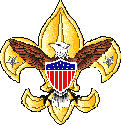|
 Radio Radio
Requirements
2002
- Explain what radio is. Include in your explanation: the differences
between broadcast radio and hobby radio, and the differences between
broadcasting and two-way communicating. Also discuss broadcast radio and
amateur radio call signs and using phonetics.
- Sketch a diagram showing how radio waves travel locally and around
the world. How do the broadcast radio stations, WWV and WWVH, help
determine what you will hear when you listen to a radio?
- Do the following:
- Draw a chart of the electromagnetic spectrum covering 100
kilohertz (kHz) to 1000 megahertz (MHz).
- Label the LF, MF, VHF, UHF, and microwave portions of the spectrum
on your diagram.
- Locate on your chart at least eight radio services such as AM and
FM commercial broadcast, CB, television, amateur radio (at least four
ham radio bands), and police.
- Discuss why some radio stations are called DX and others are
called local. Explain who the FCC and ITU are.
- Explain how radio waves carry information. Include in your
explanation: transceiver, transmitter, amplifier, and antenna.
- Learn the safety precautions for working with radio gear,
particularly DC and RF grounding.
- Do the following:
- Explain the differences between a block diagram and a schematic
diagram.
- Draw a block diagram that includes a transceiver, amplifier,
microphone, antenna, and feedline.
- Explain the differences between an open circuit, a closed circuit,
and a short circuit.
- Draw eight schematic symbols. Explain what three of the
represented parts do. Find three electrical components to match to
three of these symbols.
- Do ONE of the following: (a, b, or c )
- Amateur radio
- Describe some of the activities that amateur radio operators can
do on the air, once they have earned an amateur radio license.
- Carry on a 10 minute real or simulated radio contact using voice
or Morse Code; use proper call signs, Q signals, and abbreviations.
(Licensed ham radio operators may substitute five QSL cards as
evidence of contacts with amateur radio operators from at least
three different call districts.) Properly log the real or simulated
ham radio contact and record the signal report.
- Explain at least five Q signals or amateur radio terms you hear
while listening.
- Explain some of the Technician Class license requirements and
privileges. Explain who gives amateur radio exams.
-
Explain how you would make an emergency call on
voice or Morse code. Tell why the FCC has an amateur radio service.
-
Explain handheld transceivers versus home "base"
stations. Explain about mobile amateur radios and amateur radio
repeaters.
-
Broadcast radio
-
Prepare a program schedule for radio station "KBSA"
of exactly one-half hour, including music, news, commercials, and
proper station identification. Record your program on audio tape
using proper techniques.
-
Listen to and properly log 15 broadcast stations;
determine for five of these their transmitting power and general
areas served.
-
Explain at least eight terms used in commercial
broadcasting, such as segue, cut, and fade.
-
Discuss the educational and licensing requirements
and career opportunities in broadcast radio.
-
Short-wave listening
-
Listen across several short-wave bands for two
4-hour periods, one in the early morning and the other in the early
evening. Log the stations properly and locate them geographically on
a globe.
-
For several major foreign stations (BBC in Great
Britain or HCJB in Ecuador , for example), list several frequency
bands used by each.
-
Compare your morning and evening logs, noting the
frequencies on which your major foreign stations were loudest during
each session. Explain the differences in signal strength from one
period to the next.
-
Discuss the purpose of and careers in short-wave
communications.
-
Visit a radio installation approved in advance by your
counselor (ham radio station, broadcast station, or public service
communications center, for example). Discuss what types of equipment you
saw in use, how it was used, what types of license are required to
operate and maintain the equipment, and the purpose of the station.
|

.jpg)

 Radio
Radio